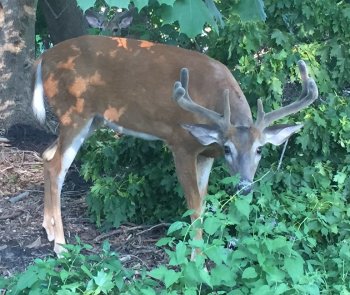White-Tailed Deer
Category: North American Mammals

Facts about White-Tailed Deer, "Scientific name for White-Tailed Deer is Odocoileus virginianus". and is an Odocoileus type of animal that comes from the Cervidae family. The White-Tailed Deer varieties hail from the United States, and they are largely found in Mexico, Canada, South America and Central America, as far as the southern parts of Peru and Bolivia. The White-Tailed Deer variety is the most extensively spread wild ungulate in the Americas. The White-tailed Deer prefers open forest, but they are regularly found on the borders of urban regions and in agricultural countries. They are found mostly in the eastern parts of the Cascade crest. Their home comprises areas along rivers and streams, mixed forests, ranches, and smoldered shrub fields. Open regions are used only when thick forest or shrubs are close by.
Features of White-Tailed Deer
The White-tailed Deer is an average-sized animal that is highly variable in dimension. The White-Tailed Deer have a body length, ranging from 37 inches (94 cm)to 87 inches (221 cm), including its tail that ranges in length from 3.9 inches (10 cm) to 14.4 inches (36.5 cm). The White-Tailed Deer varieties usually seen with a height that ranges from 21 inches (53 cm) to 47 inches (119 cm). The adult male White-tailed Deer is heavier than the female one, with a body mass of 150 pounds (45 kg), whereas the female ones weigh 100 pounds (68 kg). The White-tailed Deer from the Andes are bigger than other tropical deer of this variety and contain thick fur similar to wool.
The White-tailed Deer has a reddish-brown color coat in the summer and spring, and it turns to grey-brown color all through the winter and fall. The deer can be renowned for the characteristic white color underside to its tail. The White-Tailed Deer will lift its tail when it is distressed to inform to other deer. There is a range of white-tailed deer in the New York State that is completely white, except for regions, such as the toes and the nose. The horizontally slit pupil of this deer enables the deer to have good nocturnal vision and color vision during the daytime.
White-tailed Deer varieties are ruminant, which indicates that they have a four-chambered abdomen. Each compartment has a dissimilar and particular function that enables the deer to consume a diversity of dissimilar food quickly, digesting it afterwards in a safe region. The stomach of the White-Tailed Deer hosts a complex set of bacteria, which change while the diet of the deer changes during the seasons. If the bacteria essential for digestion of a particular food, such as hay, are absent, it will not get digested.
Diet of White-Tailed Deer
The White-tailed Deer is a herbivorous animal and it feeds on huge varieties of food, commonly feeding on legumes and foraging on other parts varieties of plants, including leaves, shoots, grasses and cacti. The White-Tailed Deer also feed on fruit, acorns and corn, poison ivy and mushrooms. Their diet differs according to the season and the accessibility of food resources. The White-Tailed Deer will also feed on hay, white clover, and other food that they can locate in a ranch. Though virtually completely herbivorous, the White-tailed Deer has been recognized to opportunistically feed on field mice, nesting songbirds and birds entrapped in Mist nets.
Behavior of White-Tailed Deer
Male White-tailed Deer vie for the chance of breeding female deer. Sparring among male breeds decides a supremacy hierarchy. They will try to copulate with as several female deer as they can, misplacing physical form as they seldom consume or relax during the rut. If there are many males in a particular region, then they will vie more for the female deer. If there are more females or fewer males, then the choice process will not require being as competitive.
Reproduction of White-Tailed Deer
Mating in Male White-tailed Deer commences during late October or early November, activated mostly by the declining photoperiod. Nearly all female deer attain the sexual maturity after one to two years of their birth, but the majority of them will not capable to reproduce pending six months following they mature. Copulation contains an ejaculatory push, which occurs during a brief copulatory leap. The size of the litter ranges from 1 to 3 juveniles.
The average life span of the White-tailed Deer ranges from 6 years to 14 years.

 Back To Category North American Mammals
Back To Category North American Mammals